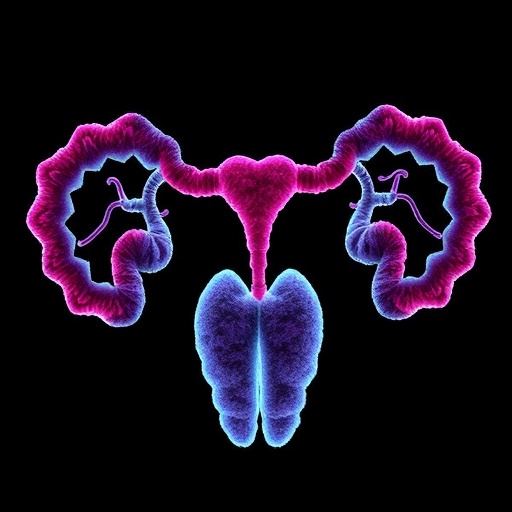In the ever-evolving landscape of medicinal chemistry, the quest for innovative therapeutic agents remains paramount. The focus of recent research has shifted towards the development of azole derivatives, specifically those that incorporate ethanolamine moieties. These compounds have garnered attention due to their potential in treating ulcerative colitis (UC), a debilitating inflammatory bowel disease characterized by inflammation of the colon and rectum. This new avenue of research explores not only the biochemical properties of these derivatives but also their interactions with critical cellular pathways that govern inflammation.
Ulcerative colitis is often associated with significant morbidity, and existing therapies are not always effective for every patient. This opens the door for continued investigation into alternative treatment strategies. The article by Ju et al. presents groundbreaking findings that illustrate how these novel azole derivatives can serve as effective anti-UC agents through their ability to inhibit the NF-κB and MAPK signaling pathways. These pathways are crucial players in the inflammatory response, and their dysregulation contributes to the severity of UC.
The NF-κB pathway, in particular, is known to mediate the expression of various pro-inflammatory cytokines, which exacerbate inflammation in conditions like UC. The research findings highlight the significance of targeting this pathway to achieve anti-inflammatory effects. By modulating the activity of NF-κB, the azole derivatives can potentially reduce the inflammatory cascade that characterizes UC, providing much-needed relief to patients suffering from this condition.
The exploration of azole derivatives containing ethanolamine moieties is a noteworthy aspect of Ju et al.’s study. Ethanolamine, a simple amino alcohol, is known for its ability to form hydrogen bonds and participate in various biochemical processes. Its inclusion in the design of azole derivatives enhances the solubility and bioavailability of these compounds, making them more pharmacologically viable. This structural modification is critical as it directly influences how well the drug can perform within a biological system.
One of the compelling features of this research is how it integrates the molecular dynamics of the azole derivatives with their biological impact. By employing various in vitro assays, the researchers demonstrated that these derivatives not only inhibited cell proliferation in inflammatory environments but also induced apoptosis in activated immune cells. This dual action signifies a promising therapeutic approach where inflammation is reduced while simultaneously managing the aberrant immune response that characterizes UC.
Furthermore, this innovative research has practical implications for the formulation of novel anti-inflammatory therapies. The authors elucidate a clear pathway from molecular design to biological efficacy, underscoring the importance of multidisciplinary approaches in drug development. In a landscape where conventional therapies may fall short, the identification and characterization of these new compounds could lead to breakthroughs in managing UC and improving patient outcomes substantially.
Distinctive features of these compounds, such as their selectivity for inflammatory pathways, point towards a new generation of anti-UC agents. This selectivity is paramount, as existing treatments often come with considerable side effects due to their broad-spectrum activity, affecting not only inflammatory pathways but also healthy tissues. The specificity exhibited by the azole derivatives might hint at a future where therapeutic options carry fewer adverse effects and higher tolerability among patients.
The advances presented by Ju and colleagues also trigger thoughts about the potential for these compounds beyond UC. Given the integral role of NF-κB and MAPK pathways in various inflammatory diseases, the implications of their findings reach into numerous other areas, such as rheumatoid arthritis and psoriasis. This broader relevance emphasizes the versatility of the azole derivatives, allowing researchers to explore their application in other therapeutic scenarios.
While this research marks a significant step forward, it also opens many questions regarding the long-term efficacy and safety of these azole derivatives in clinical settings. Future studies are essential to ensure that the promising in vitro results translate into safe and effective clinical applications. This will require extensive evaluation including rigorous preclinical and clinical trials that assess not just efficacy, but also the long-term safety profiles of the new compounds in diverse patient populations.
As the scientific community continues to evolve its understanding of complex diseases like ulcerative colitis, research such as that conducted by Ju et al. serves as a beacon of hope. It highlights the importance of innovative thinking and thorough investigation in the realm of pharmacology. The search for novel compounds, backed by solid scientific principles, reinforces the idea that with each new discovery comes the potential to drastically alter therapeutic landscapes and improve patient quality of life.
In conclusion, the investigation into azole derivatives enriched with ethanolamine moieties reflects a proactive approach in tackling the dual challenges posed by ulcerative colitis. By revealing the intricate mechanisms of action and emphasizing the importance of pathway specificity, Ju et al. have paved the way for future exploration and potential breakthroughs in the treatment of inflammatory bowel diseases. As aspects of this research advance to clinical application, the implications for patient care could be profound, heralding a new era in the management of chronic inflammatory diseases.
Subject of Research: Development of new azole derivatives containing ethanolamine moiety as anti-UC agents.
Article Title: Exploration of new azole derivatives containing ethanolamine moiety as anti-UC agents by inhibiting NF-κB/MAPK pathways.
Article References:
Ju, MQ., Huang, ZX., Mo, QY. et al. Exploration of new azole derivatives containing ethanolamine moiety as anti-UC agents by inhibiting NF-κB/MAPK pathways.
Mol Divers (2025). https://doi.org/10.1007/s11030-025-11386-1
Image Credits: AI Generated
DOI: https://doi.org/10.1007/s11030-025-11386-1
Keywords: azole derivatives, ethanolamine, ulcerative colitis, NF-κB, MAPK pathways, anti-inflammatory agents, therapeutic development.
Tags: alternative therapies for inflammatory diseasesanti-inflammatory agents developmentbiochemical properties of azole derivativescytokine expression regulationdrug discovery in ulcerative colitisethanolamine azole derivativesinflammatory bowel disease researchMAPK pathway targetingmedicinal chemistry innovationsNF-κB signaling inhibitionnovel therapeutic compounds for UCulcerative colitis treatment strategies





